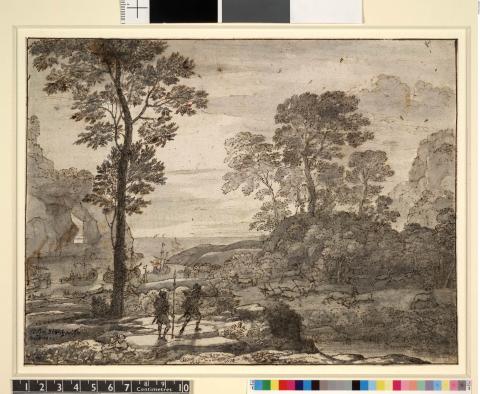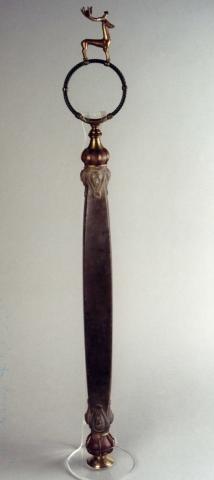Claude Lorrain: Aeneas Hunting
Annotations
Sketchbook drawing by Claude Lorraine: Coast scene with Aeneas hunting, illustration from Virgil's 'Aeneid', I, 158-93, translated by Annibale Caro, record of painting in the Musée des Beaux-Arts, Brussels from the Liber Veritatis; in foreground Aeneas and Achates hunting a herd of deer, beyond at left the Trojan fleet in a harbour. 1672 Pen and brown ink and grey wash, with grey-brown wash (British Museum)
Online Resources
Associated Passages
Subjects
Type
Image
License
Creative Commons Attribution-NonCommercial-NoDerivs
Properties
Date
1672
Medium
Dimensions
193mm x 255 mm
Inscription
Signed, inscribed and dated: "CLAVDIO/fecit/Roma/1672[formerly 1670]" and inscribed: "libro Di Virgilio/folio 10" Verso inscribed with notes
Location
London: The British Museum



This object, found in the early 7th-century Sutton Hoo ship burial, is thought to be either a whetstone or a sceptre, perhaps similar to the thuuf mentioned at the end of HE 2.16. Colgrave-Mynors notes: "An object found at Sutton Hoo in the burial ship ... is supposed by some to be a royal standard of some kind ... Bede probably got the word tufa from Vegetius [Dē Re Militārī 3.5]. The Old English word thuf (tuft of feathers or foliage) with which he equated it, suggests that the standard was bushy or covered with foliage..." (p. 192, n. 3).
See:
"Whetstone from the Sutton Hoo ship burial." British Museum.
"Whetstone or Sceptre?" Medieval Histories (7 November 2013). Web.